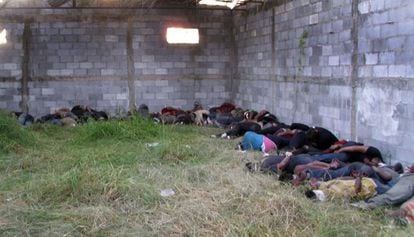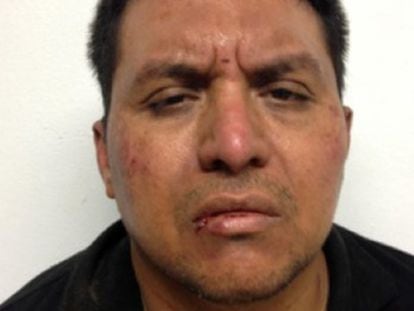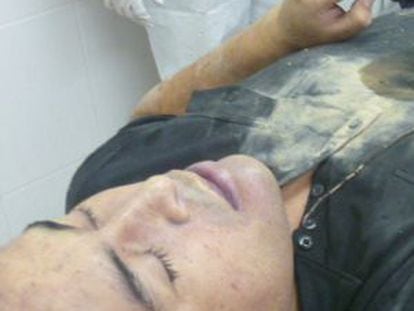Mexico’s police and state failed victims of Zetas cartel, says new report
Document slams authorities for role in two cases involving the murders of some 400 people


Of all the gangs and cartels active in Mexico’s drugs war over the last two decades, the Zetas hold a particularly gruesome place. Created in 2000 by former members of the Mexican armed forces, they quickly rose to prominence during a decade-long reign of terror during which they murdered with impunity. Their modus operandi was simple: they subjected local communities where they operated to extreme violence, typically torturing their victims and then dismembering them, often leaving bodies in public places.
A new study by journalist Sergio Aguayo, who has written extensively about Mexico’s cartels, focuses on two of the Zetas’ most notorious crimes: the murder of 72 migrants in the US border state of Tamaulipas in 2010, and the disappearance of up to 300 people in neighboring Coahuila in 2011.
The Zetas subjected local communities where they operated to extreme violence
Aguayo’s report, carried out under the auspices of the state-funded prestigious Colegio de México, is called En el desamparo (Unprotected) and draws the conclusion that the Mexican state has failed the victims of violent crime: “It has not done its job,” says Aguayo.
San Fernando, Tamaulipas, northeast Mexico, August, 2010. Statement by the sole survivor of the Zetas massacre. “They tied our hands, blindfolded us and then lined us up in a U shape. First the women, one of whom was pregnant. They told us to be quiet, not to shout, because they were going to kill us.” At the time, Aguayo, says, “San Fernando was an extermination camp.”
The 72 men and women, following a well-used migrant route into the United States, were in the wrong place at the wrong time. The Zetas and the Golfo cartel were at war for control of Tamaulipas state, home to border crossings such as Reynosa, Matamoros and Nuevo Laredo. The Zetas had heard that the Golfo cartel was recruiting migrants to fight them. When it came across the group of 72, gang members took them to an isolated farm and made them a counter offer: work for them. Three apparently said yes, said the only survivor, although what happened to them is not clear.
Aguayo’s report implicates all levels of government in Mexico
“They were finished off with a bullet in the back of the head,” a member of the Zetas involved in the killing later told police. “When it was all over, we didn’t lose any sleep over it.”
Allende, Coahuila state, northern Mexico. March 2011. It is still unclear exactly how many people were killed in this small town some 20 kilometers south of the Texas border crossing of Piedras Negras. It was not until early 2014 when the authorities began searching for the remains of at least 300 local people who had been murdered and buried in outlying farms. The victims had been seized by members of the Zetas in retaliation for the theft of $5 million by an associate of the cartel’s leaders. Some 80 houses were destroyed by heavy machinery, and around 80 families were kidnapped and never seen again. The remains of a number of bodies dissolved in diesel fuel were found in large barrels, but could not be identified. Local police reportedly stood by as the Zetas went about their grisly business.
“The forces of law and order did exactly what they were told,” says Aguayo’s report: “They did not carry out patrols or respond to emergency calls.”
“In 2010 and 2011, the Zetas had 38 police officers in San Fernando on their payroll and 20 in Allende,” says the report. “Some took part in the killings, others simply kept away and did nothing.” Aguayo details that the cost at the time of the atrocities of buying a police officer’s silence was $300 a month.
The Zetas have been seriously weakened in recent years
Three of the men who ordered the slaughter are in the United States, two of whom are believed to be in a witness protection scheme. Aguayo’s report criticizes the US authorities for their “lack of transparency” in answering requests for information.
The conclusion of Aguayo’s report is devastating: it implicates all levels of government. “The municipal administration was complicit in serious human rights violations, the state government of Tamaulipas was indifferent, and that of Coahuila insufficient. What did the federal authorities do or allow to be done? The information at our disposal is insufficient to understand the actions and omissions of the federal government,” concludes the report.
The Zetas have been seriously weakened in recent years: Heriberto Lazcano, one of its founders, is dead. Miguel Ángel Treviño, known as Z-40, is in jail. The organization has largely fallen apart as a result, and Aguayo says it is hard to know who is in charge. That said, its capacity for violence has not diminished, and it is still active in states along Mexico’s Gulf Coast, notably in Tamaulipas and Veracruz.
English version by Nick Lyne.












































